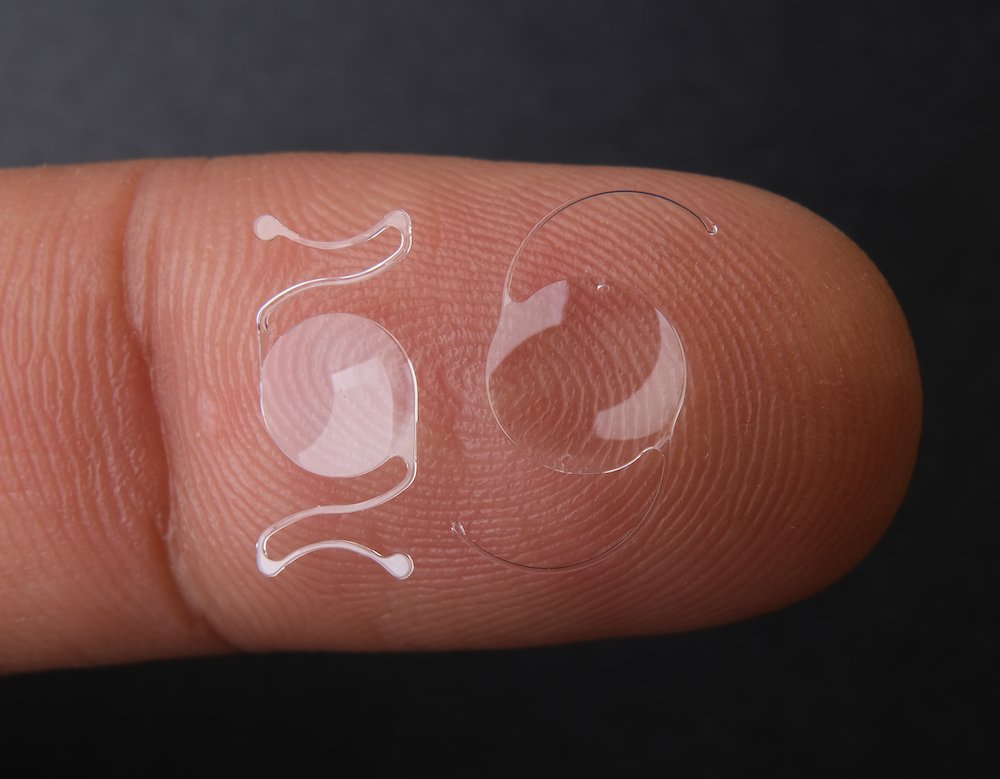If you have been told by your eye doctor that you have a cataract and need surgery to remove it, then you will also need to choose a lens implant during the surgery. There are many different types of IOLs (intraocular lenses) available, and it can be difficult to decide which one is right for you. In this blog post, we will discuss the different types of cataract lenses IOL available and help you decide which one is right for you.
What Is The IOL In Cataract Surgery?
 IOL in cataract surgery is an intraocular lens. It is a clear, flexible disc that is placed in the eye during cataract surgery to help focus light. IOLs are made of different materials, including plastic, silicone, and acrylic. There are many different types of IOLs available, and your doctor will choose the best one for you based on your individual needs.
IOL in cataract surgery is an intraocular lens. It is a clear, flexible disc that is placed in the eye during cataract surgery to help focus light. IOLs are made of different materials, including plastic, silicone, and acrylic. There are many different types of IOLs available, and your doctor will choose the best one for you based on your individual needs.
The most common type of IOL is the monofocal IOL. This type of IOL helps you to see clearly at one distance, usually far away. Monofocal IOLs are the most basic type of IOL and are typically covered by insurance. If you have a monofocal IOL, you may still need to wear glasses or contact lenses for reading or other close-up tasks.
Moreover, IOL in cataract surgery is considered the best method to correct vision. It can be used for those who:
- Are not suitable for contact lenses
- Suffer from dry eye
- Have had previous refractive surgery
- Have an irregular cornea
All these factors are important to consider when choosing the right IOL for you. Also, you should understand that cataract is a progressive disease and you may need to have your IOL replaced or adjusted over time.
Different Types Of Cataract Lenses IOL
Cataract surgery is one of the most commonly performed surgeries in the United States. More than three million people have cataract surgery each year, and that number is expected to grow as the population ages. During cataract surgery, the cloudy lens of your eye is removed and replaced with a clear artificial lens. This artificial lens is called an intraocular lens, or IOL.
There are several different types of IOLs available, and the type that is best for you will depend on your individual needs and lifestyle. Some of the most common types of cataract lenses IOL include:
Monofocal IOLs
These are the most common type of IOL, and they provide good distance vision. If you choose a monofocal IOL, you will likely need to wear glasses or contact lenses for reading and close-up work. This type of IOLs is generally the most affordable. Because this is a one-time surgery, many people choose to upgrade to a premium IOL later on.
Multifocal IOLs
If you want to reduce your dependence on glasses or contact lenses, you may want to consider a multifocal IOL. These lenses provide good distance and near vision, and they can also help with intermediate vision. You may still need to wear glasses or contact lenses for some activities, such as reading the fine print. Also, studies have found that people who have multifocal IOLs are more likely to experience halos and glare around lights, especially at night.
Extended-depth-of-focus (EDOF) IOLs
 These lenses are similar to multifocal IOLs, but they provide a wider range of intermediate vision. This can be helpful for people who spend a lot of time on the computer or reading. Like multifocal IOLs, EDOF IOLs can cause halos and glare around lights. It is also important to note that EDOF IOLs are very much new technology, and long-term data is not yet available.
These lenses are similar to multifocal IOLs, but they provide a wider range of intermediate vision. This can be helpful for people who spend a lot of time on the computer or reading. Like multifocal IOLs, EDOF IOLs can cause halos and glare around lights. It is also important to note that EDOF IOLs are very much new technology, and long-term data is not yet available.
Accommodative IOLs
As we age, the muscles in our eyes can lose some of their flexibility, which can make it difficult to focus on close objects. If you have presbyopia (age-related farsightedness), you may want to consider an accommodative IOL. This type of IOL uses a hinged design to provide focusing power. It is important to note that not all people are candidates for this type of IOL, and it is still considered experimental.
Toric IOLs
If you have astigmatism, you may want to consider a toric IOL. This type of IOL is designed to correct astigmatism, and it can provide good distance vision. Toric IOLs are also available in multifocal and accommodative designs. It is also important to note that not all people are candidates for this type of IOL.
The best way to determine which type of IOL is right for you is to talk to your eye doctor. He or she will be able to evaluate your individual needs and lifestyle and make a recommendation based on that. No matter what type of IOL you choose, it is important to have realistic expectations about your vision after surgery.
What Are The Pros And Cons?
When you are looking at the different types of cataract lenses IOLs, it is important to know the pros and cons of each type. This will help you make the best decision for your needs. Let’s further discuss the pros and cons of the types of cataract lenses IOL, these include:
Pros
There are a few pros when it comes to the different types of cataract lenses IOLs. Some of these are:
- You have a larger range of vision with these lenses.
- They can provide you with better night vision.
- These lenses can help to protect your eyes from harmful UV rays.
- You will have reduced lifetime costs of contact lenses or glasses.
- More active and improved quality of life.
Cons
There are a few cons when it comes to the different types of cataract lenses IOLs. Some of these are:
- You may experience some glare or halo effects around bright lights, especially at night.
- You may not be able to see as well in low light conditions as you could with a regular monofocal.
- There is a small risk of developing an infection or inflammation inside the eye after surgery.
If you are considering having cataract surgery, talk to your doctor about which type of IOL would be best for you. There are many different options available, and the right one for you will depend on your individual needs and lifestyle. But you must be aware of the pros and cons of each type before making a decision. Eventually, you can choose the best IOL for your needs so that you can enjoy a clear vision for years to come.
How Long Do IOL Lenses Work?
 This is often one of the first questions people ask their eye doctor when they learn they have cataracts. The truth is, there is no one definitive answer to this question.
This is often one of the first questions people ask their eye doctor when they learn they have cataracts. The truth is, there is no one definitive answer to this question.
The average lifespan of an IOL lens is about 15 years. However, some people have reported that their IOL lenses have lasted much longer than this. There are also a small number of people who have needed to replace their IOL lenses after just a few years.
Ultimately, the lifespan of an IOL lens will depend on a variety of factors, including the health of your eyes, the type of IOL lens you choose, and how well you take care of your eyes. In addition, it is also important to keep in mind that IOL technology is constantly evolving. This means that the lenses available today are likely to last longer than the lenses that were available a few years ago.
If you are concerned about the longevity of your IOL lens, be sure to discuss this with your eye doctor. They will be able to give you more specific information based on your individual situation. Because IOL lenses are not covered by insurance, it is important to make sure you are comfortable with your choice before you have the surgery.
How To Choose The Right One?
There are different types of cataract lenses, each with its own advantages and disadvantages. The type of lens you choose will depend on your individual needs and preferences. Here are some things to keep in mind when choosing the right type of lens for you:
- Your lifestyle: If you have an active lifestyle, you may want to consider a lens that is less likely to become dislodged or damaged.
- Your vision needs: If you have special vision needs, such as needing to see at both near and far distances, you will need to choose a lens that can accommodate those needs.
- Your budget: There are lenses available at a variety of price points, so it is important to consider what you are willing to spend on a lens. Your budget is the most important factor when it comes to choosing the right type of lens for you.
- Do your research: When you are ready to make a decision, be sure to do your research and talk to your doctor about which type of lens is right for you.
If you are considering having cataract surgery, be sure to talk to your doctor about which type of lens would be best for you. They will be able to help you make the decision that is right for your individual situation. Moreover, different types of cataract lenses offer different benefits, so it is important that you choose the one that best suits your lifestyle and needs. With the right information, you can make the best decision for your eye health.
Conclusion
In conclusion of the above, the types of cataract lenses IOL are various and each has its own unique features. The best way to choose the right one is by consulting with an ophthalmologist who can help narrow down the choices and make the best decision for your individual case. Also, you should not hesitate to ask questions about the different types of IOLs available and what would be the best option for you.
Remember, this is your eye health we are talking about so it is important to make an informed decision! You can also contact EyeMantra for more information and resources.
At EyeMantra we have a team of experienced eye surgeons, who will be happy to answer your questions on cataract surgery, cataract surgery cost, and cataract lens cost for different cataract surgery types- Phacoemulsification, MICS & Femto Laser Cataract. Call us at +91-9711116605 or email at [email protected] for inquiries.


